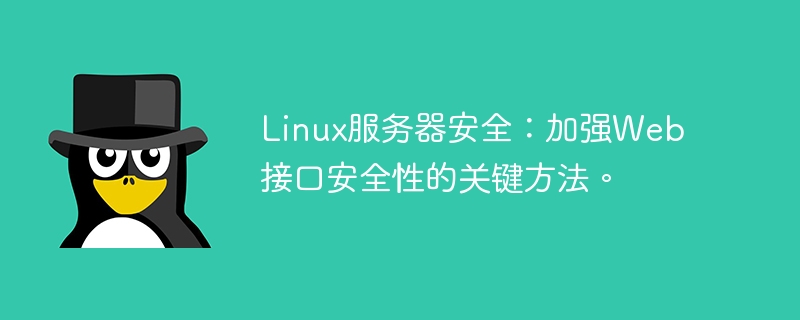

Linux Server Security: Key Methods to Strengthen Web Interface Security
[Introduction]
With the rapid development of the Internet, Web applications have become a modern An integral part of life and business. However, security threats are also increasing. In order to protect the security of user data and corporate confidential information, it is particularly important to strengthen the security of web interfaces. This article will introduce some key methods to help you enhance the security of web interfaces on Linux servers.
[1. Use HTTPS to encrypt communication]
The HTTPS protocol prevents the risk of data being intercepted and stolen by encrypting communication content. By using an SSL certificate, secure communication between the server and the client can be achieved. In order to use HTTPS, you need to install a certificate on the server and configure the server software. The following is a sample code to configure the Nginx server to support HTTPS:
server { listen 443 ssl; server_name example.com; ssl_certificate /path/to/certificate.crt; ssl_certificate_key /path/to/private.key; location / { // 其他配置代码... } }
[2. Use firewall to restrict access]
By setting firewall rules, you can restrict access to the Web interface. Only allowing specific IP addresses or IP address ranges to access the server can effectively prevent unauthorized access. The following is a sample code for setting firewall rules using iptables:
# 关闭所有入站和出站连接 iptables -P INPUT DROP iptables -P FORWARD DROP iptables -P OUTPUT DROP # 允许特定IP地址访问特定端口 iptables -A INPUT -p tcp -s 192.168.1.100 --dport 80 -j ACCEPT iptables -A INPUT -p tcp -s 192.168.1.200 --dport 443 -j ACCEPT iptables -A OUTPUT -p tcp -d 192.168.1.100 --sport 80 -j ACCEPT iptables -A OUTPUT -p tcp -d 192.168.1.200 --sport 443 -j ACCEPT
[3. Using WAF (Web Application Firewall)]
WAF is a firewall used to detect and block malicious attacks in web applications. technology. It can perform real-time monitoring and protection against common web attacks such as SQL injection and cross-site scripting attacks (XSS). By using a WAF, you can add a layer of protection to your web interface. The following is a sample code that uses ModSecurity to configure WAF:
# 安装ModSecurity apt-get install libapache2-mod-security2 # 配置ModSecurity vi /etc/apache2/mods-enabled/security2.confSecRuleEngine On SecRuleRemoveById 900015 SecRuleEngine DetectionOnly
[4. Regularly update and upgrade software]
In order to prevent known vulnerabilities from being exploited, it is very important to regularly update and upgrade the software on the server . Usually, Linux distributions provide security updates and patches, and you just need to execute the relevant commands. The following is a sample code for updating Ubuntu server software:
apt-get update apt-get upgrade
[5. Use strong passwords and multi-factor authentication]
To prevent passwords from being guessed or brute force cracked, it is crucial to use strong passwords. A strong password should contain letters, numbers, and special characters and be at least 8 characters long. Additionally, for added security, multi-factor authentication can be enabled. The following is a sample code that uses the PAM module to configure strong passwords and multi-factor authentication:
# 安装PAM模块 apt-get install libpam-google-authenticator # 配置PAM模块 vi /etc/pam.d/common-password password required pam_google_authenticator.so password required pam_permit.so
[Conclusion]
The security of the web interface on the Linux server can be strengthened by taking a series of security measures. This article covers key methods such as using HTTPS to encrypt communications, using firewalls to limit access, using WAFs, regularly updating and upgrading software, and using strong passwords and multi-factor authentication. I hope these methods can help you improve the security of your server and protect your web interface from malicious attacks.
The above is the detailed content of Linux Server Security: Key Ways to Strengthen Web Interface Security.. For more information, please follow other related articles on the PHP Chinese website!




